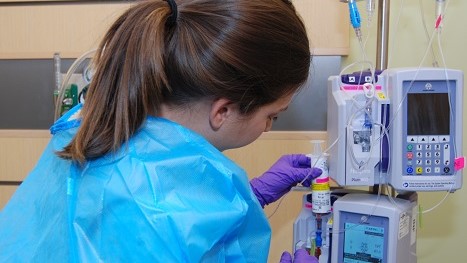

Overview
The adverse health effects associated with antineoplastic agents (cancer chemotherapy drugs, cytotoxic drugs) in cancer patients and some non-cancer patients treated with these drugs are well documented. The very nature of antineoplastic agents make them harmful to healthy cells and tissues as well as the cancerous cells. For cancer patients with a life-threatening disease, there is certainly a great benefit to treatment with these agents. However, for the health care workers who are exposed to antineoplastic agents as part of their work practice, precautions should be taken to eliminate or reduce exposure as much as possible. Pharmacists who prepare these drugs or nurses who may prepare and/or administer them are the two occupational groups who have the highest potential exposure to antineoplastic agents. Additionally, physicians and operating room personnel may also be exposed through the treatment of patients. Hospital staff, such as shipping and receiving personnel, custodial workers, laundry workers and waste handlers, all have potential exposure to these drugs during the course of their work. The increased use of antineoplastic agents in veterinary oncology also puts these workers at risk for exposure to these drugs.
Sustainable Development Goals (SDGs)
- Goal 3: Good Health and Well-being
- Goal 8: Decent Work and Economic Growth
- Goal 12: Responsible Consumption and Production
- Goal 13: Climate Action
Long-term Effects
- Liver and kidney damage
- Damage to the bone marrow
- Damage to the lungs and heart
- Infertility (temporary and permanent)
- Effects on reproduction and the developing fetus in pregnant women
- Hearing impairment
- Cancer
The International Agency for Research on Cancer (IARC) in Lyon, France has identified a number of antineoplastic agents and two combination therapies as having an association with cancer in patients who are treated with them. These include both cancer and non-cancer patients. IARC currently lists eleven agents and two combined therapies as Group 1 (Human carcinogens), twelve as Group 2A (Probable human carcinogens) and eleven as Group 2B (Possible human carcinogens).
Worker Exposure
A number of studies have documented environmental and worker exposure to the antineoplastic agents. A variety of biological endpoints have been used to evaluate worker exposure. These include, urine mutagenicity, chromosomal damage, sister chromatid exchange, micronuclei induction, DNA damage, HPRT mutations, and thioether excretion.
Additionally, analytical methods have been used to document worker exposure to antineoplastic agents by measuring these drugs and/or their metabolites in the urine of health care workers.
Similar analytical methods are currently being employed to measure the level of environmental contamination in the workplace. Although the studies on air sampling are limited, there have been numerous studies published on environmental wipe sampling for these drugs.
NIOSH Alert
In September, 2004, The National Institute for Occupational Safety and Health (NIOSH) published an Alert: Preventing Occupational Exposures to Antineoplastic and Other Hazardous Drugs in Health Care Settings, 2004 (DHHS (NIOSH) Publication No. 2004-165). This topic page is an expanded bibliography of related publications drawn from the published literature related to the Alert. Additional information on this topic can also be found on the NIOSH Hazardous Drug Exposures in Health Care page.
SDGs, Targets, and Indicators
| SDGs | Targets | Indicators |
|---|---|---|
| SDG 3: Good Health and Well-being | Target 3.9: By 2030, substantially reduce the number of deaths and illnesses from hazardous chemicals and air, water, and soil pollution and contamination | Indicators: – Number of deaths and illnesses related to exposure to hazardous chemicals – Level of environmental contamination in the workplace |
| SDG 8: Decent Work and Economic Growth | Target 8.8: Protect labor rights and promote safe and secure working environments for all workers | Indicators: – Number of workers exposed to hazardous drugs – Level of worker exposure to antineoplastic agents |
| SDG 12: Responsible Consumption and Production | Target 12.4: By 2020, achieve the environmentally sound management of chemicals and all wastes throughout their life cycle, in accordance with agreed international frameworks, and significantly reduce their release to air, water, and soil in order to minimize their adverse impacts on human health and the environment | Indicators: – Level of environmental contamination from antineoplastic agents – Effectiveness of measures taken to reduce environmental contamination |
1. Which SDGs are addressed or connected to the issues highlighted in the article?
- SDG 3: Good Health and Well-being
- SDG 8: Decent Work and Economic Growth
- SDG 12: Responsible Consumption and Production
2. What specific targets under those SDGs can be identified based on the article’s content?
- Target 3.9: By 2030, substantially reduce the number of deaths and illnesses from hazardous chemicals and air, water, and soil pollution and contamination
- Target 8.8: Protect labor rights and promote safe and secure working environments for all workers
- Target 12.4: By 2020, achieve the environmentally sound management of chemicals and all wastes throughout their life cycle, in accordance with agreed international frameworks, and significantly reduce their release to air, water, and soil in order to minimize their adverse impacts on human health and the environment
3. Are there any indicators mentioned or implied in the article that can be used to measure progress towards the identified targets?
- Number of deaths and illnesses related to exposure to hazardous chemicals
- Level of environmental contamination in the workplace
- Number of workers exposed to hazardous drugs
- Level of worker exposure to antineoplastic agents
- Level of environmental contamination from antineoplastic agents
- Effectiveness of measures taken to reduce environmental contamination
4. Table: SDGs, Targets, and Indicators
| SDGs | Targets | Indicators |
|---|---|---|
| SDG 3: Good Health and Well-being | Target 3.9: By 2030, substantially reduce the number of deaths and illnesses from hazardous chemicals and air, water, and soil pollution and contamination | – Number of deaths and illnesses related to exposure to hazardous chemicals – Level of environmental contamination in the workplace |
| SDG 8: Decent Work and Economic Growth | Target 8.8: Protect labor rights and promote safe and secure working environments for all workers | – Number of workers exposed to hazardous drugs – Level of worker exposure to antineoplastic agents |
| SDG 12: Responsible Consumption and Production | Target 12.4: By 2020, achieve the environmentally sound management of chemicals and all wastes throughout their life cycle, in accordance with agreed international frameworks, and significantly reduce their release to air, water, and soil in order to minimize their adverse impacts on human health and the environment | – Level of environmental contamination from antineoplastic agents – Effectiveness of measures taken to reduce environmental contamination |
Source: cdc.gov







